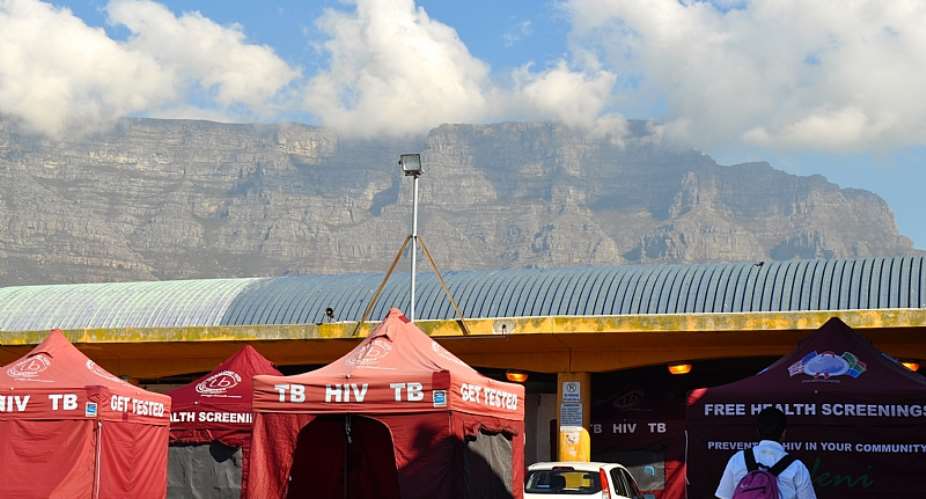A campaign to encourage more people to test for HIV has led to hundreds of commuters and taxi drivers flocking to a mobile clinic, consisting of eight tents, set up on the deck of Cape Town’s main train station.
Teams of counsellors and nurses are offering HIV counseling and testing, screening for TB and diabetes as well as blood pressure checks and advice on family planning. They are distributing condoms and asking about possible symptoms of Sexually Transmitted Infections (STIs) during the three-week stint on the busy station deck.
“The tents are never empty. There are always people getting tested. It’s very exciting. We’re helping by giving people the power to keep themselves healthy, and if HIV positive, to get medical attention,” said Leandie September, Target 5000 Coordinator for the Desmond Tutu TB Centre (DTTC) at Stellenbosch University.
The tents have been set up as part of the Target 5000 Campaign, funded by the President’s Emergency Plan for AIDS Relief (PEPFAR) through the US-based Centre for Disease Control and Prevention (CDC). The target is to get an extra 5,000 people in Cape Town tested for HIV within three months.
The DTTC has taken up the challenge. With the help of the City of Cape Town Health Directorate, they were able to set up a mobile operation, bringing in a caravan, eight tents and teams of counsellors, nurses, data clerks as well as mobilisers who spread the word about the service.
During the day, two people with loudhailers walk up and down the crowded station deck, taxi rank and shops, encouraging people to test, while others hand out pamphlets and direct people to the tents.
Petronella Njiva, who runs a small hairdressing salon on the station deck, said it was a very convenient service.
“I work seven days a week, so this is good for me. I can go and test for free right here and then get back to work. It only takes fifteen minutes to get my results from the HIV test.”
The response has exceeded the expectations of the DTTC so far.
“It’s been fantastic. People are getting tested who wouldn’t typically go to a clinic for an HIV test. Over half of the people who have come to get tested are men. Many young people and people who are not aware of any signs or symptoms of disease are popping in. We’re providing early case detection and linkage to HIV care,” said Sue-Ann Meehan, who heads up the Community HIV Prevention Programme (COMAPP) for the DTTC.
Taxi driver, Sindiso Busakwa, liked the convenience as well, saying many drivers did not have time to queue at a clinic to get tested for HIV.
“This is so much easier than going to the clinic, because the service is coming to us. We don't always have a good reputation as taxi drivers. We want to change that. We want to set a good example by testing for HIV and encouraging others to do the same.”
Despite a drop in new HIV infections in South Africa, many people are still falling through the cracks, and haven’t been tested or been treated for HIV.
“We need to halt the HIV epidemic in South Africa by increasing access to HIV testing, finding people who are HIV infected and linking them to care at public health clinics so that they can get treated,” said Meehan.
Findings so far have indicated that about six percent of people who have accessed the mobile clinics at the Cape Town station are HIV positive. This is compared to about four percent in the communities where COMAPP usually works.
In addition to Target 5000, COMAPP sets up its caravans and tents on a smaller scale every day in five communities throughout Cape Town, taking its services to shopping centres, taxi ranks and other busy areas.
The Target 5000 campaign will move to the busy Bellville and Du Noon taxi ranks, as well as the Wallacedene community near Kraainfontein in late July and August.
The campaign is also working towards the 90-90-90 targets set by UNAIDS.
UNAIDS has set targets that 90% of all people living with HIV will know their HIV status by 2020, with 90% of people with diagnosed HIV infections receiving sustained antiretroviral therapy. It’s third goal is for 90% of people who receive antiretroviral treatment to have viral suppression.





 Former Kotoko Player George Asare elected SRC President at PUG Law Faculty
Former Kotoko Player George Asare elected SRC President at PUG Law Faculty
 2024 elections: Consider ‘dumsor’ when casting your votes; NPP deserves less — P...
2024 elections: Consider ‘dumsor’ when casting your votes; NPP deserves less — P...
 You have no grounds to call Mahama incompetent; you’ve failed — Prof. Marfo blas...
You have no grounds to call Mahama incompetent; you’ve failed — Prof. Marfo blas...
 2024 elections: NPP creates better policies for people like us; we’ll vote for B...
2024 elections: NPP creates better policies for people like us; we’ll vote for B...
 Don’t exchange your life for wealth; a sparkle of fire can be your end — Gender ...
Don’t exchange your life for wealth; a sparkle of fire can be your end — Gender ...
 Ghana’s newly installed Poland train reportedly involved in accident while on a ...
Ghana’s newly installed Poland train reportedly involved in accident while on a ...
 Chieftaincy disputes: Government imposes 4pm to 7am curfew on Sampa township
Chieftaincy disputes: Government imposes 4pm to 7am curfew on Sampa township
 Franklin Cudjoe fumes at unaccountable wasteful executive living large at the ex...
Franklin Cudjoe fumes at unaccountable wasteful executive living large at the ex...
 I'll 'stoop too low' for votes; I'm never moved by your propaganda — Oquaye Jnr ...
I'll 'stoop too low' for votes; I'm never moved by your propaganda — Oquaye Jnr ...
 Kumasi Thermal Plant commissioning: I pray God opens the eyes of leaders who don...
Kumasi Thermal Plant commissioning: I pray God opens the eyes of leaders who don...
